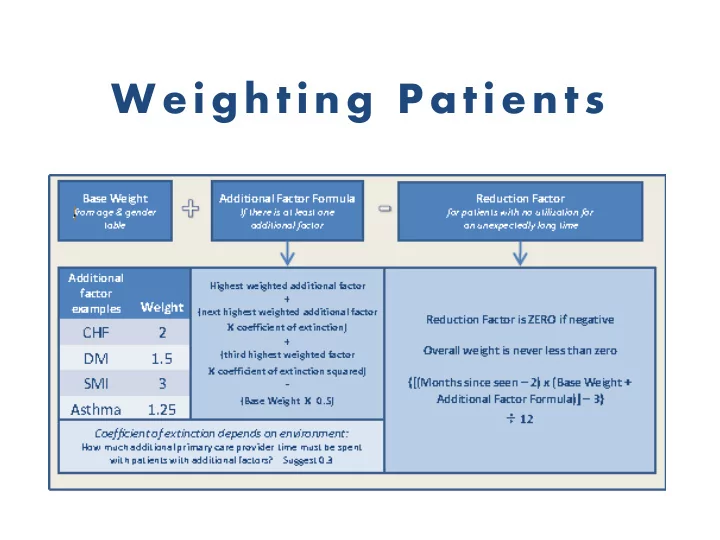

Weighting Patients
Determine Base Weight
Add Addit ion al F act or s • Determine what accounts for the additional primary care time associated with management of chronic diseases and other related factors. (This only includes provider’s time.)
Determin e th e Coefficien t of Ex tin guis h me n t • Each additional condition will not require the full amount of time as it would when have if addressed alone. • To determine the weight of each additional condition (factor), the weight of the factor should be divided in ½.
Accoun t for In active P at ie n t s • Reduction Factors need to be applied if for example a patient with a condition that requires follow-up visits every 2 months and has not been seen for over 4 months.
Accoun t for In active P at ie n t s • Add the individual patient weights together for all patients empaneled. This gives the total weight of the panel.
Assessment of Outcome • Needs to be done on a periodic basis. • Will determine if provider’s panel should be open or closed. • The experience of the patients, providers, and their teams should be assessed in comparison to the weighted panels. • Look for teams that are experiencing stress vs. teams that are humming along with good patient experience, well coordinated care, adequate access, and low staff burnout.
Single Cut Method • Assign a score to each visit that a patient has had in the prior 24 months. • Color codes will be used to distinguish which provider saw the patient. • The score differing by the timeframe in which the visit occurred. – The score amount will decrease with each earlier visit.
PCP Identification Logic
Refining Panels • Within the 6 months of initial empanelment many empaneled as well as new patients will have had some interaction with the practice, e.g. a visit or phone call. Based on data and information from the interactions, a practice can adjust the panels. • Because this is a dynamic process, developing the initial panels might need changes and adjustments.
Open in g & Closin g P an e ls • It is critical to continuously review panel data to determine when a provider’s panel should be closed to additional patients. • Partially closed panels may work for particular types of patients. An example would be paneling patients that have been seen by the provider in the hospital.
Where to Start • Phase 0 – Pre-empanelment work: – Weighting the patients • Phase 1 – Developing initial panels – Single Cut method • Phase 2 – Refining panels • Phase 3 – On going empanelment
Recommend
More recommend